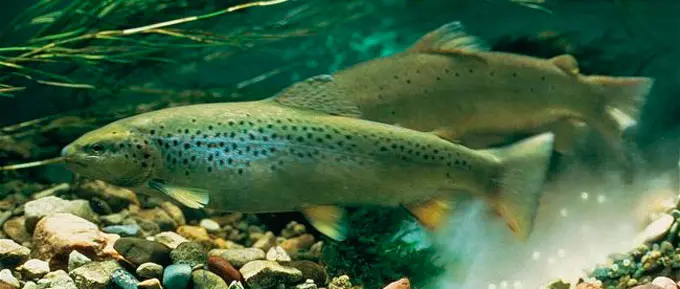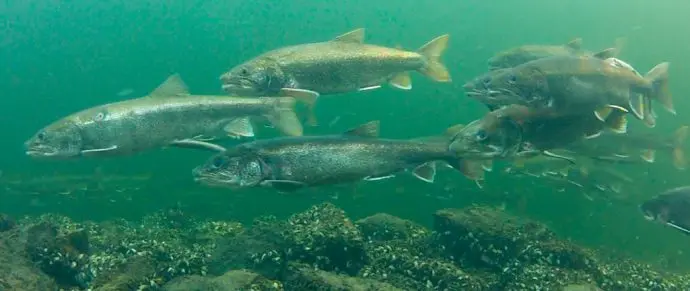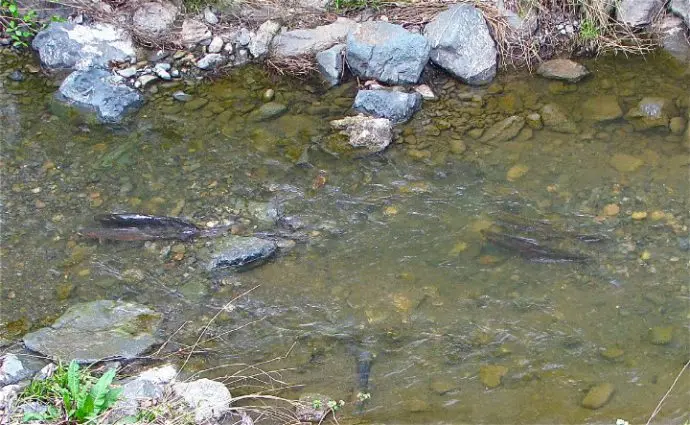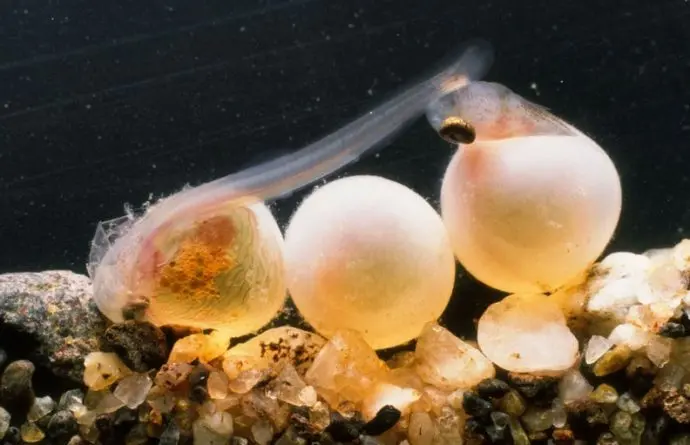Contents

Trout spawning is something out of the ordinary because it doesn’t fit into the usual understanding of fish reproduction. This process is interesting in that it takes place in a completely different way than in other types of fish. That’s exactly what this article will be about.
When the trout goes to spawn

In the third year of life, the trout is ready to spawn and is ready to go to the places where it spawns every year. Moreover, there are species of this fish that begin to spawn at two years, and there are also species whose maturity is observed at 5-6 years. Common brook trout do this at 3 years of age. Most species of fish lay their eggs in spring, when nature begins to come alive. Moreover, each species of fish tries to spawn in acceptable conditions, when the water temperature begins to rise actively. Unfortunately, trout is not one of these types of fish, because its spawning occurs in late autumn or early winter. This is the period when there is no longer any talk about spawning fish. Somewhere in October-November, the trout goes to spawn. The period can be shifted depending on the climatic features of the region and the type of trout. The colder the climate zone, the earlier it goes to spawn.
The earliest spawning period is September, and the latest is December. At the same time, it should be noted that there are species of this fish that spawn throughout the year. And yet, the main species of trout begin to spawn in October-November.
After the trout has appeared on the traditional breeding grounds, it begins to actively spawn. Moreover, she does this early in the morning or late in the evening, after sunset. In the morning hours, it does not show high activity, but after dark and before midnight, the activity of the trout is the highest. Females get rid of all the eggs in several approaches, taking rest breaks. At the same time, she will be able to sweep all the eggs no earlier than a week.
Trout spawning grounds

With the arrival of autumn, the trout begin to move up the river to their favorite places for spawning. At the same time, it overcomes various obstacles or waterfalls, up to 4 meters high. This indicates how strong this fish is and how strongly the reproductive instinct is developed.
Excellent places for spawning can be sections of the river, located near the rapids and having a fast current. The bottom of such areas should be covered with stones. It is among the stones that the trout prefers to lay eggs. In addition, interesting places for trout are sections of the river, the bottom of which is littered with small pebbles, up to 3 cm in size. If for some reason the fish could not reach a suitable place, then it can spawn in areas where the bottom is littered with large pebbles . The depth of the reservoir in these areas is not large and can reach no more than 1 meter. Therefore, its spawning can be observed from the shore.
How is trout spawning going?

Having found a suitable place, the female begins to form a small depression at the bottom. All parts of the body are involved in this process. After that, she lays several dozen eggs in this hole, after which the male immediately fertilizes her. The female tries not to allow younger males to the process of fertilization, taking care of the health of her offspring.
After that, the female buries this place so that the eggs are not eaten by predators or carried away by the current. Despite the fact that the caviar adheres perfectly to any object at the bottom of the river, this effect quickly disappears and the caviar is carried away by the current. Knowing this, the female does everything very quickly. Despite this, few will survive, especially since the incubation process is not fast. Moreover, even the trout fry that were born will not all reach their favorite places, where they will spend the rest of their lives.
Trout caviar is the size of allspice peas of a greenish or orange-red hue. The female can lay 500 to 2000 eggs. After about 2-3 months, trout fry will be born, about 2 cm long. For some time they feed on the yolk sac, which remains with them from eggs. At the same time, they are between the stones, without leaving their shelter for a long time. After they grow up a little and get stronger, the period of independent search for food begins. During this period, they switch to feeding on plankton.
Strengthened and surviving fry begin to roll downstream in the spring. There is usually enough food for growth downstream. From feeding on plankton, they switch to feeding on small insects that, for one reason or another, have fallen into the water. The next stage is mayfly hunting, and so on. Already by autumn, the “little thing” of trout reaches a length of 9 cm. After about 2 years of life, the trout will reach a length of 20 cm and will be considered a full-fledged individual suitable for fishing.
The fact that trout spawn during periods of cold is a unique phenomenon, since it is difficult to imagine how an embryo develops in such cold water. Although trout is not the only representative that breeds in such conditions. If we take, for example, burbot, then it generally spawns in the midst of severe frosts, which occur at the end of December and in January. And this amazing phenomenon is worthy of its attention. Moreover, this indicates how strong Mother Nature is and how great her possibilities are.
Video “Trout spawning, underwater view”
Brown trout spawning mating breeding shedding fish eggs underwater. Spawning trout.










Nagyon érdekes a történet! Megszeretném osztani!! S nagyon gyönyörű a ZENE, a DAL! KÖSZÖNÖM!